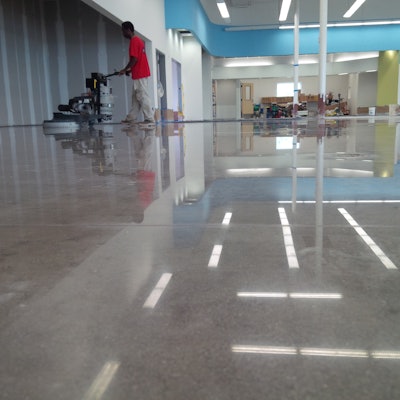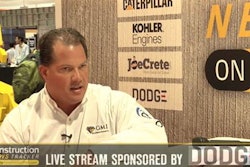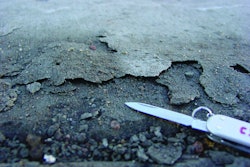
Since the moment polished concrete was born, it was important to have a quantifiable standard for the level of finish that was being produced. The first best practices documents written in our industry described the process of concrete polishing. They broke out the various levels of grinding and began with heavy grit metal bond abrasives that were operated in a wet environment. The refinement process was not only followed by the polishing industry, it was also understood that sequencing steps would need to follow the selected starting grit in order to have a clean, scratch-free finish. The polished floors that were produced with this basic concept provided a consistent finish and a relatively predictable outcome.
When the industry evolved into a completely dry polishing system as an alternative way to polish concrete, we saw a similar progressive sequence of steps that also focused on a high degree of refinement and produced a comparative and predictable finish as the older polishing systems had proven.
Many of the discussions early on about the quality of finishes being produced was always settled by using a gloss meter. This quantitative measurement would give the end user a quantifiable standard to write into a polishing specification and the facility was virtually guaranteed to get two things at once: 1) a highly processed and refined floor, and 2) a gloss level that was easy to achieve by selecting a resin bonded abrasive tool that could increase the gloss level if higher progressive grits were run over the last polishing grit selected.
Over the past 7 years, end users have been experiencing sustainability issues they had never encountered before. Like other trades in the construction industry, having a competitive advantage is key to winning competitive bids. Many companies are extremely successful at value engineering their process or maximizing efficiencies with innovative attachments and proprietary tools, or simply they just have a more organized labor force. The construction trades are also represented by contractors that disregard a focus on turning over a quality project and end up racing their competition straight to the bottom on price and quality. Unfortunately, the polishing industry is no different.
In today’s polished concrete world, we see a wide range of systems and equipment and just as many varying types of specially formulated chemicals and abrasives with only one quantitative standard — the gloss meter. No fault to the gloss meter, some of the topical concrete polishing sealers have the ability to cover heavy metal bond scratches, change the texture from rough to smooth, and even increase the gloss number on projects that were tested with failing readings. These “tricks of the trade” have caused end users to spend much more than expected on maintenance systems to keep their floors looking as good as the day they were finished. These floors are not holding their own. Why? Surface refinement has been ignored by processes that endorse skipping progressive steps and not properly chasing the scratch out of the surface.
Function and sustainability are the positive attributes of polished concrete. Our industry is working hard to provide clear language about the quality of a polished concrete surface beyond its ability to record scattered light with a gloss meter.
About new standard
ST-115 is a standard for the polishing industry that was adopted by the Concrete Sawing and Drilling Association (CSDA). The standard explains in detail how to measure texture of a concrete surface using a T Meter (texture meter). Over the past 2 years, I had the honor of being the chair of 16 experts in the field of surface metrology, concrete finishing, concrete repair and concrete mix designs. These experts represent five major industry associations — ACI, CSDA, ASTM, ASME, ICRI — and five continents. They assembled the concrete industry’s first standard document for quantifying a concrete surface by accurately reading its texture and assigning the proper designation code, or STG (surface texture grade).
This is the first standard of its kind for the concrete industry but not a new standard to other industries. The metal and plastic finishing industries adopted similar standards more than 50 years ago because they experienced the same challenges with interpretation and processing techniques the concrete polishing industry faces.
The standard numerically assigns a texture grading code to a finish. Now the design community and end users alike can begin to have a more structured conversation about the quality and sustainability of a polished concrete surface and also determine if steps in the polishing process were skipped or avoided. The standard covers the possibility of encountering surfaces that contain high amounts of flaw, roll out or voids and addresses how to properly honor these character flaws in the surface and get a reliable reading. ST-115 also equips the processor of the polished floor system with a valuable device that enables them to monitor the refinement process of a specific tool in a multiple tooling system process and measure the surface of the concrete after its work has been completed. This allows the processor to monitor the quality of abrasives he is using from his current supplier and gives him the ability to compare similar abrasives made by competitive manufacturers. The processor can record the resulting finish grade to potentially assemble the best tool selection procedure for his particular equipment or process. ST-115 is a detailed map of surface measurement that will catch any minor adjustment or deviations from the surface. The quantitative surface refinement number is always accurate and does not give results that vary depending on the type of polish guard or sealer that was used. The one thing that will always remain constant and true about surface finishing is any surface with a high degree of refinement can only produce a byproduct called gloss. You can never have a highly refined floor without gloss, ever.
ST-115 is not biased, does not takes sides, does not allow cheating and does not favor one polished system over the other (wet v/s dry); it only reads the real surface. Used in conjunction with gloss meters and DOI (distinction of image) meters, ST115 tells a compelling story about the quality of a finish and changes the current discussions of “how long is it going to last” to “how long can it last.”
Processes of theory have run their course and the era of not knowing how long a finish is going to last is behind us now. Polished concrete is here for good and a cooperative group of industry experts have been assembled and are working very hard to simplify the vocabulary and test methods for everyone to understand it better. Providing more sustainable polished concrete floor systems will be what drives our industry.
About the Author
Andy Bowman is the Surface Metrology Specialist at Adaptive Concrete Innovations based in Rose Bud, Ark. He has 13 years experience in concrete design mixes, concrete placement, concrete finishing and concrete polishing. He is the lead trainer for the CSDA’s Concrete Polishing training classes. Bowman can be reached at 419-408-5906 or by email at [email protected].



















